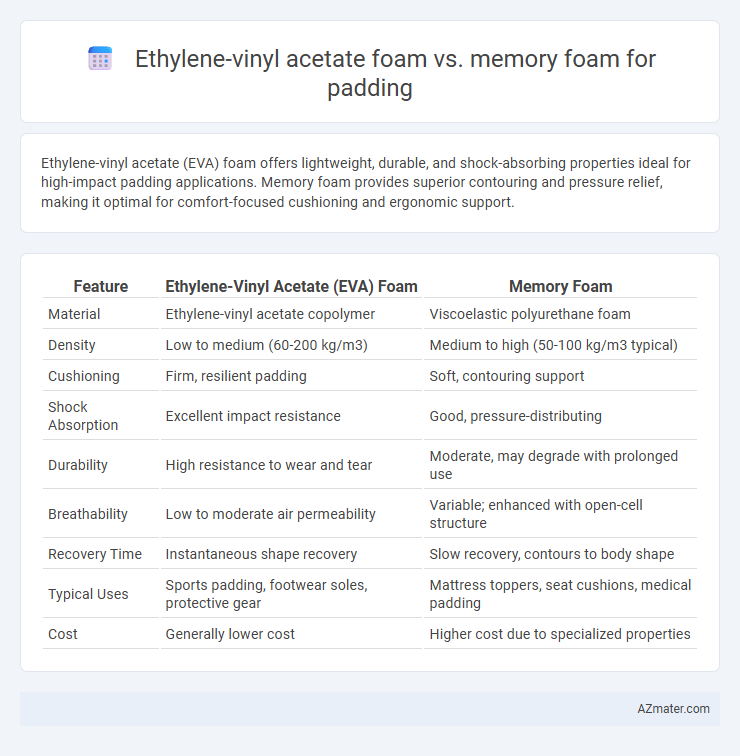Ethylene-vinyl acetate (EVA) foam offers lightweight, durable, and shock-absorbing properties ideal for high-impact padding applications. Memory foam provides superior contouring and pressure relief, making it optimal for comfort-focused cushioning and ergonomic support.
Table of Comparison
| Feature | Ethylene-Vinyl Acetate (EVA) Foam | Memory Foam |
|---|---|---|
| Material | Ethylene-vinyl acetate copolymer | Viscoelastic polyurethane foam |
| Density | Low to medium (60-200 kg/m3) | Medium to high (50-100 kg/m3 typical) |
| Cushioning | Firm, resilient padding | Soft, contouring support |
| Shock Absorption | Excellent impact resistance | Good, pressure-distributing |
| Durability | High resistance to wear and tear | Moderate, may degrade with prolonged use |
| Breathability | Low to moderate air permeability | Variable; enhanced with open-cell structure |
| Recovery Time | Instantaneous shape recovery | Slow recovery, contours to body shape |
| Typical Uses | Sports padding, footwear soles, protective gear | Mattress toppers, seat cushions, medical padding |
| Cost | Generally lower cost | Higher cost due to specialized properties |
Introduction to Ethylene-vinyl Acetate (EVA) Foam and Memory Foam
Ethylene-vinyl acetate (EVA) foam is a lightweight, flexible material known for its excellent impact absorption and water resistance, making it ideal for sports padding and footwear insoles. Memory foam, composed of viscoelastic polyurethane, contours to the body by responding to heat and pressure, offering superior comfort and support in cushioning applications. Both materials serve distinct purposes in padding, with EVA foam excelling in durability and resilience, while memory foam prioritizes personalized comfort and pressure relief.
Composition and Manufacturing Process
Ethylene-vinyl acetate (EVA) foam consists of a copolymer of ethylene and vinyl acetate, produced through a foaming process that incorporates chemical blowing agents for lightweight, resilient padding. Memory foam is made from viscoelastic polyurethane, created via a reaction between polyols and diisocyanates, followed by additives that control viscosity and density to achieve its distinctive slow recovery and pressure-relieving properties. EVA foam manufacturing typically involves extrusion or compression molding, while memory foam requires precise temperature and pressure controls during curing to optimize its viscoelastic characteristics.
Comfort and Cushioning Properties
Ethylene-vinyl acetate (EVA) foam offers excellent resilience and a firm yet flexible cushioning, making it ideal for high-impact comfort and durable padding applications. Memory foam provides superior contouring and pressure relief by adapting to body shape and distributing weight evenly, enhancing comfort in prolonged use. While EVA foam excels in durability and bounce-back, memory foam outperforms in softness and personalized support, making each suitable for different cushioning needs.
Durability and Longevity Comparison
Ethylene-vinyl acetate (EVA) foam offers superior durability due to its resistance to compression set, moisture, and environmental stress, making it ideal for long-lasting padding applications. Memory foam, while providing excellent comfort and pressure relief, tends to degrade faster under repeated compression and heat exposure, reducing its overall lifespan. EVA foam maintains its structural integrity longer, whereas memory foam often requires replacement sooner due to sagging and loss of resilience.
Support and Pressure Relief
Ethylene-vinyl acetate (EVA) foam provides firm support by maintaining shape under pressure, making it ideal for applications requiring durable padding with moderate pressure relief. Memory foam contours closely to body shape, offering superior pressure relief by distributing weight evenly and reducing stress on pressure points. For enhanced support combined with effective pressure alleviation, memory foam outperforms EVA foam in cushioning applications like mattresses and ergonomic seating.
Weight and Flexibility Differences
Ethylene-vinyl acetate (EVA) foam is significantly lighter than memory foam, making it ideal for applications where weight reduction is crucial, such as sports equipment and footwear padding. EVA foam offers superior flexibility and resilience, quickly regaining its shape after compression, whereas memory foam exhibits higher density with slower recovery due to its viscoelastic properties. The higher weight and slower responsiveness of memory foam provide enhanced contouring and pressure relief, but at the expense of reduced flexibility compared to the lightweight, durable EVA foam.
Temperature Sensitivity and Breathability
Ethylene-vinyl acetate (EVA) foam offers superior breathability compared to memory foam due to its open-cell structure, allowing better air circulation and moisture dissipation, which reduces heat retention during use. Memory foam is highly temperature-sensitive, softening and conforming to body heat for personalized cushioning but often traps heat, leading to less comfort in warm environments. EVA foam maintains consistent cushioning regardless of temperature changes, making it ideal for applications requiring durable, breathable padding with minimal thermal impact.
Common Applications in Padding
Ethylene-vinyl acetate (EVA) foam is widely used in sports equipment padding, footwear insoles, and protective gear due to its lightweight, shock-absorbing properties and durability. Memory foam, favored for its viscoelastic characteristics, is commonly applied in mattress toppers, seat cushions, and healthcare padding to provide superior pressure relief and customized comfort. Both materials serve distinct roles in padding, with EVA excelling in impact resistance and memory foam in contouring support.
Cost and Value Analysis
Ethylene-vinyl acetate (EVA) foam typically offers a lower cost option compared to memory foam, making it budget-friendly for large-scale applications. EVA foam provides durable, lightweight padding with moderate cushioning, whereas memory foam, despite its higher price, delivers superior pressure relief and long-term comfort due to its viscoelastic properties. The value analysis favors memory foam for products requiring enhanced ergonomic support, while EVA foam is preferred for cost-sensitive projects demanding resilience and basic comfort.
Which Foam is Best for Your Needs?
Ethylene-vinyl acetate (EVA) foam offers excellent durability, water resistance, and firm cushioning, making it ideal for outdoor gear and sports padding. Memory foam excels in pressure relief and contouring to body shape, providing superior comfort and support for mattresses and seating applications. Choosing the best foam depends on whether you prioritize resilience and moisture resistance (EVA) or adaptive comfort and pressure distribution (memory foam) for your specific padding needs.

Infographic: Ethylene-vinyl acetate foam vs Memory foam for Padding
 azmater.com
azmater.com